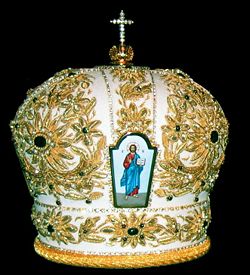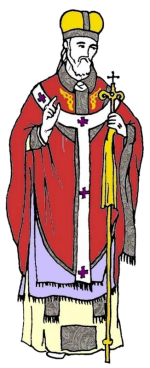Difference between revisions of "Miter"
(interwiki ro, ru) |
(→Refersnce) |
||
| (7 intermediate revisions by 3 users not shown) | |||
| Line 8: | Line 8: | ||
The wearing of the miter is a prerogative of bishops, but it may be awarded to [[archpriest]]s, [[protopresbyter]]s, and [[archimandrite]]s. | The wearing of the miter is a prerogative of bishops, but it may be awarded to [[archpriest]]s, [[protopresbyter]]s, and [[archimandrite]]s. | ||
| − | == | + | ==Western miter== |
| − | + | [[Image:WR-Bishop vestments by Fr. Aidan.png|thumb|left|150px|A bishop wearing an older style of the western miter]] | |
| + | The mitre is a western headdress with many forms. It is worn by bishops and abbots. | ||
| + | |||
| + | Both the western style of the miter and the Papal tiara stem from the ''camelaucum'' (Greek: [[Kamilavka|καμιλαύκιον]], ''kamilaukion''), which was originally a cap used by officials of the Imperial Byzantine court. "The tiara [from which the mitre originates] probably developed from the Phrygian cap, or frigium, a conical cap worn in the Greco-Roman world. In the 10th century the tiara was pictured on papal coins."<ref>Britannica 2004, ''tiara''</ref> Other sources claim the tiara developed the other way around, from the mitre. In the late Empire it developed into the closed type of Imperial crown used by Byzantine Emperors. | ||
| + | |||
| + | In Western Europe, the mitre was first used in ancient Rome by the [[Salii]] and other priests, and outside of Rome about the year 1000. Worn by a bishop, the mitre is depicted for the first time in two miniatures of the beginning of the eleventh century. The first written mention of it is found in a Bull of Pope Leo IX in the year 1049. By 1150 the use had spread to bishops throughout the West; by the 14th century the tiara was decorated with three crowns. | ||
| + | |||
| + | Nowadays, the miter is in most cases a pointed cap with two peaks: front and back. The early English or medieval style is short, of decorated or undecorated linen; the Roman style much taller, of rigid material. | ||
| + | |||
| + | [[Image:Mitre evolution.gif|thumb|center|550px|The evolution of the mitre]] | ||
| + | |||
| + | ==Reference== | ||
| + | <references/> | ||
| + | |||
| + | ==See also== | ||
| + | *[[Clergy awards]] | ||
==External links== | ==External links== | ||
| − | *[http://www.newadvent.org/cathen/10404a.htm | + | *[http://www.newadvent.org/cathen/10404a.htm Catholic Encyclopedia on the miter] |
| − | *[http://www.1911encyclopedia.org/Mitre Mitre] | + | *[[w:Mitre|Wikipedia on the miter]] |
| + | *[http://www.1911encyclopedia.org/Mitre Encyclopaedia Britannica 1911 on the Mitre] | ||
[[Category: Vestments]] | [[Category: Vestments]] | ||
| Line 20: | Line 36: | ||
[[ro:Mitră]] | [[ro:Mitră]] | ||
[[ru:Митра]] | [[ru:Митра]] | ||
| + | [[el:Μίτρα]] | ||
Latest revision as of 05:18, March 23, 2012
The miter, also spelled mitre, in Orthodox Christian usage is a type of head-covering worn by certain clergy of the Orthodox Church as a part of their ceremonial dress. The word is derived from the Greek μίτρα, meaning a 'headband' or 'turban'.
A head-covering, as a mark of position of certain religious and secular officials, has a long history. In ancient Israel the Jewish high priest (Kohen Gadol) wore a headdress called the Mitznefetthat wound around the head to form a broad, flat-top topped turban. Officials of the court of the Eastern Roman Empire wore a cap called the camelaucum (Greek: καμιλαύκιον kamilaukion) that developed into the imperial crown by the ninth century. A miter in the imperial form was not use by Orthodox bishops until after the fall of Constantinople in 1453. Today, the typical miter in Orthodox churches is based on the imperial crown of the late Eastern Roman Empire.
The present day miter is made in the shape of a bulbous crown and may be constructed of number of materials such as brocade, damask, or cloth of gold. Embroidery may be used in its construction as well as use of jewels for decoration. The miters, while often of gold, may use other liturgical colors. Normally, there are four icons attached to the miter. These usually are icons of Jesus Christ, the Theotokos, John the Baptist, and the Cross. A cross surmounts the miter, either upright for bishop’s miters or laying flat on miters awarded to priests.
The wearing of the miter is a prerogative of bishops, but it may be awarded to archpriests, protopresbyters, and archimandrites.
Western miter
The mitre is a western headdress with many forms. It is worn by bishops and abbots.
Both the western style of the miter and the Papal tiara stem from the camelaucum (Greek: καμιλαύκιον, kamilaukion), which was originally a cap used by officials of the Imperial Byzantine court. "The tiara [from which the mitre originates] probably developed from the Phrygian cap, or frigium, a conical cap worn in the Greco-Roman world. In the 10th century the tiara was pictured on papal coins."[1] Other sources claim the tiara developed the other way around, from the mitre. In the late Empire it developed into the closed type of Imperial crown used by Byzantine Emperors.
In Western Europe, the mitre was first used in ancient Rome by the Salii and other priests, and outside of Rome about the year 1000. Worn by a bishop, the mitre is depicted for the first time in two miniatures of the beginning of the eleventh century. The first written mention of it is found in a Bull of Pope Leo IX in the year 1049. By 1150 the use had spread to bishops throughout the West; by the 14th century the tiara was decorated with three crowns.
Nowadays, the miter is in most cases a pointed cap with two peaks: front and back. The early English or medieval style is short, of decorated or undecorated linen; the Roman style much taller, of rigid material.
Reference
- ↑ Britannica 2004, tiara


